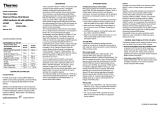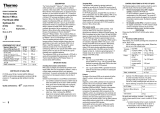Page is loading ...

PRODUCT INFORMATION
M-MuLV Reverse
Transcriptase
Pub. No. MAN0012025
Rev. Date 17 June 2016 (Rev. B.00)
#EP0352
Lot: _ Expiry Date: _
Components
#EP0352
M-MuLV Reverse
Transcriptase, 20 U/µL
5000 U
5X Reaction Buffer
5 1 mL
Store at -20 °C
www.thermofisher.com
For Research Use Only. Not for use in diagnostic procedures.
Description
M-MuLV Reverse Transcriptase (RT) is an RNA- and
DNA-dependent DNA polymerase. The enzyme
possesses a ribonuclease H activity specific to RNA in
RNA-DNA hybrids (1, 2). M-MuLV RT incorporates
modified nucleotides.
Source
E.coli cells with a cloned fragment of the pol gene
encoding Moloney Murine Leukemia Virus reverse
transcriptase.
Applications
First strand cDNA synthesis for RT-PCR and real-time
RT-PCR, see protocol on back page.
Synthesis of cDNA for cloning and expression.
Generation of labeled cDNA probes for microarrays.
DNA labeling (3).
Analysis of RNA by primer extension (3).

Definition of Activity Unit
One unit of the enzyme incorporates 1 nmol of dTMP into
a polynucleotide fraction in 10 min at 37 °C.
Storage Buffer
The enzyme is supplied in: 50 mM Tris-HCl (pH 7.5),
0.1 M NaCl, 1 mM EDTA, 5 mM DTT, 0.1% Triton X-100
and 50% glycerol.
5X Reaction Buffer
250 mM Tris-HCl (pH 8.3 at 25 °C), 250 mM KCl,
20 mM MgCl2, 50 mM DTT.
Inhibition and Inactivation
Inhibitors: metal chelators, inorganic phosphate,
pyrophosphate and polyamines (3).
Inactivated by heating at 70 °C for 10 min.
Note
M-MuLV RT has significantly lower RNase H activity than
Avian Myeloblastosis Virus (AMV) reverse transcriptase.
CERTIFICATE OF ANALYSIS
Endodeoxyribonuclease Assay
No detectable degradation was observed after
incubation of supercoiled plasmid DNA with M-MuLV
Reverse Transcriptase.
Ribonuclease Assay
No detectable degradation was observed after incubation
of [3H]-RNA with M-MuLV Reverse Transcriptase.
Labeled Oligonucleotide (LO) Assay
No detectable degradation after incubation of single-
stranded or double-stranded radiolabeled
oligonucleotides with M-MuLV Reverse Transcriptase.
Functional Assay
M-MuLV Reverse Transcriptase was tested for use in
the first strand cDNA synthesis.
Quality authorized by: Jurgita Zilinskiene
(continued on back page)

Protocol for First Strand cDNA Synthesis
The following protocol is optimized to generate first-strand
cDNA for use in two-step RT-PCR.
Mix and briefly centrifuge all components after thawing,
keep on ice.
1. Add into sterile, nuclease-free tube on ice in the indicated
order:
Template
RNA
total RNA
or
poly(A) RNA
or
specific RNA
100 ng-5 µg
10-500 ng
0.01 pg-0.5 µg
Primer
Oligo(dT)18 (#SO131)
or
Random hexamer
(#SO141)
or
gene-specific primer
0.5 µg (100 pmol)
0.2 µg (100 pmol)
15-20 pmol
DEPC-treated water (#R0601)
to 11.5 µL
2. Optional: If RNA template is GC rich or is known to
contain secondary structures, mix gently, centrifuge
briefly and incubate at 65 °C for 5 min, chill on ice, briefly
centrifuge and place on ice.
3. Add the following components in the indicated order:
5X reaction buffer
4 µL
Thermo Scientific RiboLock RNase
Inhibitor (#EO0381)
0.5 µL (20 U)
dNTP Mix, 10 mM each
(#R0191)
2 µL (1 mM final
concentration)
M-MuLV Reverse Transcriptase
2 µL (40 U)
Total volume
20 µL
Mix gently and centrifuge briefly.
4. If oligo(dT)18 primer or gene-specific primer is used,
incubate 60 min at 37 °C.
If random hexamer primer is used, incubate 10 min
at 25 °C followed by 60 min at 37 °C.
For transcription of GC rich RNA reaction temperature
can be increased to 45 °C.
5. Terminate the reaction by heating at 70 °C for 10 min.
Do not heat-inactivate enzyme prior to analysis of long
cDNA to avoid cleavage.
Note
The reverse transcription reaction product can be directly
used in PCR or stored at -20 °C.
Use 2 µL of the reaction mix to perform PCR in 50 µL
volume.

References
1. Verma, I.M., Reverse transcriptase, The Enzymes (Boyer, P.D.,
ed), Academic Press Inc., vol. 14, 87-103, 1981.
2. Gerard, G.F. and D'Alessio, J.M., Methods in Molecular Biology,
16, Humana Press, Totowa, N.J., 73-93, 1993.
3. Sambrook, J., Russell, D.W., Molecular Cloning:
A Laboratory Manual, the third edition, Cold Spring Harbor
Laboratory Press, Cold Spring Harbor, New York, 2001.
LIMITED USE LABEL LICENSE: Internal Research and Development Use Only.
The purchase of this product conveys to the buyer the limited, non-exclusive, non-
transferable right (without the right to resell, repackage, or further sublicense) to use
this product for internal research and development purposes. No other license is
granted to the buyer whether expressly, by implication, by estoppel or otherwise. In
particular, the purchase of the product does not include or carry any right or license
to use, develop, or otherwise exploit this product commercially and no rights are
conveyed to the buyer to use the product or components of the product for purposes
including but not limited to provision of services to a third party, generation of
commercial databases or clinical diagnostics. This product is sold pursuant to
authorization from Thermo Fisher Scientific and Thermo Fisher Scientific reserves all
other rights. For information on purchasing a license for uses other than internal
research and development purposes, please contact [email protected] or
Out Licensing, Life Technologies Inc., 5791 Van Allen Way, Carlsbad, California
92008.
PRODUCT USE LIMITATION
This product is developed, designed and sold exclusively for research purposes and
in vitro use only. The product was not tested for use in diagnostics or for drug
development, nor is it suitable for administration to humans or animals.
Please refer to www.thermofisher.com for Material Safety Data Sheet of the product.
© 2016 Thermo Fisher Scientific Inc. All rights reserved. All trademarks are the
property of Thermo Fisher Scientific Inc. and its subsidiaries.
/









